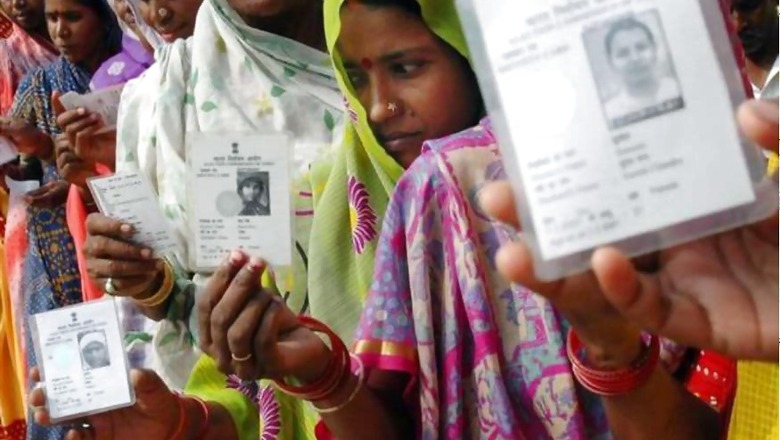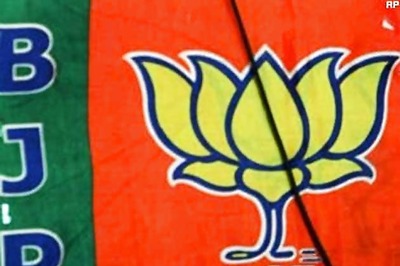
views
New Delhi: As Arunachal Pradesh gears up for Assembly elections, the politics in the state is taking interesting turns. Three Bharatiya Janata Party (BJP) candidates for the Assembly seats have already won unopposed.
Earlier, the state’s BJP General Secretary Jarpum Gamlin, state home minister Kumar Wali and tourism minister Jarkar Gamlin joined the National People’s Party. Jarpum’s sister, Jarjum Ete, had resigned from the Congress and joined the Janta Dal (Secular) to contest against Congress’s Nabam Tuki in Arunachal West.
The frontier state will simultaneously vote for the general and Assembly elections in the first phase on April 11. The state has 60 Assembly and two parliamentary constituencies.
Prime Minister Narendra Modi addressed a rally in the state on Wednesday and termed the Congress’s election manifesto a “hypocrisy document” and“full of lies”.
But issues like Permanent Residence Certificate, Citizenship Amendment Bill and Trans Arunachal Highway compensation scam have become planks for the opposition to hang on to in the upcoming elections.
The state can be a textbook case to understand why Congress’s manifesto for the Lok Sabha polls promised to amend the Anti-defection Law to instantly disqualify members switching from one party to another and to bar them from holding any public office.
Jumping Ships
The tribal state has a history of revolt, mergers and defections. Arunachal Pradesh has been a battleground for the Congress and the BJP.
Since February 2016, the state has seen three chief ministers and President’s rule, making the state’s political landscape unstable. However, Pema Khandu of BJP has led a comparatively stable government since early 2017.
In December 2016, the BJP came to power after 33 of the 43 members of the People’s Party of Arunachal (PPA) joined it. This large scale defection, however, was not for the first time.
In 1996 also, chief minister Gegong Apang revolted against the Congress and formed his own party, Arunachal Congress (AC). He took 54 MLAs to the newly-formed party and continued to govern the state. However, in the 1999 Assembly elections, people again gave their mandate to the Congress.
Mukul Mithi, the forest minister in Apang’s cabinet, who was fired by Apang for revolting, became the next chief minister. Mithi had formed his own party Arunachal Congress (Mithi), which he later merged with the Congress.
Owing to the vulnerability for sharing its border with China (other than Myanmar and Bhutan), the state leaders have largely chosen to align with the party ruling at the Centre. Like in 2004 Assembly polls, Apang won the election on a Congress ticket but switched over to the BJP side with other legislators of his Assembly to align himself with the Atal Bihari Vajpayee government at the Centre. It was the first time that a BJP government was formed in the state, without voters’ choice.
As NDA lost the general election to the UPA, Apang returned to the Congress. He headed the government till April 9, 2007, when the Congress MLAs revolted against him under Dorjee Khandu.
In late 2011, the chief ministership was taken over from Jarbom Gamlin by Nabam Tuki. Tuki continued to be the chief minister till January 2016, after which the state went under President’s rule. Proving his majority in the Assembly, PPA’s Kalikho Pul was sworn in as the next chief minister. He got support from the BJP and 29 Congress legislators, who had moved to the PPA.
The government got reduced to minority with support from 21 Congress MLAs and two independent MLAs. Calling it illegal, the Supreme Court reinstated the dismissed Congress government. Tuki took over on July 13, 2016 only to resign few hours before the floor test. He was succeeded by Khandu.
Khandu repeated the en masse switch, this time to PPA, in September 2016. In a month’s time, Khandu formally joined the BJP, resulting him being suspended by the PPA. Before PPA could replace him as the chief minister with their leader Takam Pario, the Khandu proved his majority and is been ruling the state now.
PRC in Cold Storage?
Minister Nabam Rebia-led Joint High Power Committee (JHPC) had recommended the issuance of PRCs to the non-Arunachal Pradesh Scheduled Tribe (APST) communities, among others. The report had asked to provide PRCs to “[any] non-APST person or his/her descendent… who proves that he/she had been continuously residing in his/her original place of residence/settlement prior to 1968” for the Namsai and Changlang districts. The report, however, was not tabled in the Assembly owing to protests.
Arunachal was established as a state in 1987. The region was constitutionally part of Assam and was administered by the Assam Governor until 1972. The six non-APST communities including Deoris, Sonowal Kacharis, Morans, Adivasis and Mishings, are the recognised scheduled tribes of Assam. They have been living in Namsai and Changlang districts for decades. The JHPC report addresses their belongingness to the land, which however contradicts to the Bengal Eastern Frontier Regulation (BEFR), 1873.
BEFR, 1873 has maintained prohibition for the non-natives to buy land in the tribal state. The report, thus, had enraged the public, claiming three lives in February. However, the sections 2 and 4 of the BEFR, 1873 authorises the state government to make the necessary amendments.
There is no record for most of these communities in Arunachal (then NEFA) in the 1961 and 1971 Census reports. The 1961 report suggests that there were only eight Mishings in the state. As per the 1971 report, there were 2,683 Deoris and 3,359 Mishings. As per the JHPC report, if accepted, the claimants have to furnish “cadastral survey records/ chittha registers of 1968” or pattas as “primary documentary evidence” to seek PRCs, that has to be “authenticated by the Deputy Commissioner of the concerned district.”
Following the uproar, the government had refused to take up the PRC issue again.
Progress and Hurdles
In February, Prime Minister Narendra Modi had launched developmental projects worth Rs 4,000 crore, claiming that the development trajectory of the state had gone up ever since the BJP had come to power. The Centre had also approved about 13% of the funds under the North East Special Infrastructure Development Scheme (NESIDS)—the second highest allocation—for the state. The NESIDS has budgeted an outlay of Rs 1,600 crore for 2017-18 to 2019-20.
Amid the development narrative, the state has the highest number of foot march polling stations (518), where even election officials have to trek for days to reach. The state had recorded a voter turnout of 72% in the 2014 elections.



















Comments
0 comment